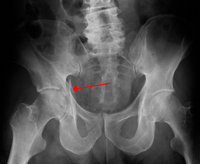
Photo from wikipedia
Objectives The aim of this study was to evaluate the clinical and radiological results of the surgical treatment of acetabular fractures using modified Stoppa approach. Methods A total of 57… Click to show full abstract
Objectives The aim of this study was to evaluate the clinical and radiological results of the surgical treatment of acetabular fractures using modified Stoppa approach. Methods A total of 57 patients (mean age 37.8 years; range 15–84) who underwent surgical treatment for acetabular fracture with modified Stoppa approach from February 2013 to June 2016 were included into the study. The mean follow-up time was 28.1 months (range 24–35). The records were reviewed for fracture patterns, time to surgery, operative time, blood loss, reduction quality, and perioperative complications. Reduction quality was graded as anatomic, imperfect, or poor. The Harris Hip Score (HHS) and Merle d'Aubigné score were used for functional evaluation. Results Among the 63 acetabulum fractures of the 57 patients, 27 were associated with both columns, 12 were T-type fractures, 10 were transverse, 7 were anterior column/posterior hemitransverse, 5 were anterior column, and 2 were anterior wall fracture. A single surgeon performed all operations. Pfannenstiel incision was used in the first 19 cases while vertical midline incision in the remaining 38 cases. Average time to operation was 5.5 days, and supplemental lateral windows were used in 17 (29.8%) patients. Average blood loss and operation times were 660 mL and 152 min, respectively. Radiological outcomes were anatomic, imperfect, and poor in 52 (82.5%), 9 (14.2%), and 2 (3.2%) of the acetabulum fractures, respectively. Clinical outcomes at 2 years with HHS and Merle d’Aubigné scores were mean 86.6 (range 66–96) (Excellent in 27, good in 23, fair in 4, poor in 3 patient) and 16.7 (range 10–18) (Excellent in 25, very good in 18, good in 6, fair in 5, poor in 3 patient), respectively. There was a significant relation between the reduction quality and clinical outcome (p < 0.001), while there was no significant relation between the clinical outcome and the fracture type (p > 0.05). Iatrogenic external iliac vein damage was noted in 2 patients. Obturator nerve palsy was noted in 3 patients, who recovered spontaneously at mean time of 3.7 months (range 3–5). Rectus abdominus paralysis was noted in 2 of the 19 (10.5%) Pfannenstiel-incision patients but not in the vertical-incision patients. Conclusion Our experience in 57 patients shows that satisfactory results can be obtained, even in bilateral fractures with vertical midline incision. Level of evidence Level IV Therapeutic Study
Journal Title: Acta Orthopaedica et Traumatologica Turcica
Year Published: 2019
Link to full text (if available)
Share on Social Media: Sign Up to like & get
recommendations!